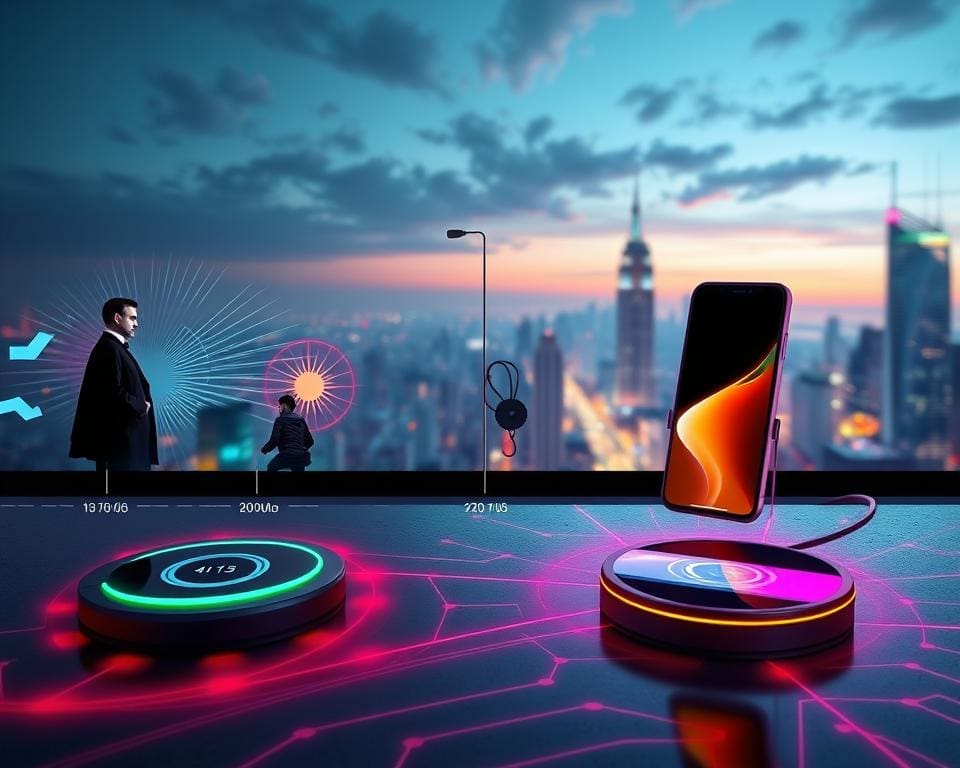In an era defined by technological advancement, wireless chargers have emerged as a revolutionary force, enabling a seamless experience of cordless charging for Qi-enabled devices. Gone are the days of tangled cables and the constant struggle to find the right charger. With just a simple placement of your device onto a charging pad or stand, powering up has never been easier or more efficient.
The significance of this technology lies not only in its convenience but also in the enhancements in charging efficiency. As we embrace the future, wireless charging is becoming increasingly essential, allowing users with multiple Qi-enabled devices to enjoy a harmonious blend of accessibility and style.
The Evolution of Wireless Charging Technology
The journey of wireless charging technology reveals a fascinating blend of creativity and ingenuity. Pioneers in the field have shaped the history of wireless charging, leading to the robust innovations we see today. Each breakthrough marks a critical step, enhancing user experience and driving the market forward.
History of Wireless Power Transfer
The history of wireless charging can be traced back to the late 19th century with Nikola Tesla’s groundbreaking experiments. His vision of transferring electricity without wires laid the foundation for future developments. Fast forward to the 21st century, the introduction of inductive charging systems represented a significant leap. The establishment of the Qi standard by the Wireless Power Consortium in 2008 brought further legitimacy and uniformity to wireless charging, allowing multiple devices to charge seamlessly.
Key Innovations in Wireless Charging
Significant progress in wired technology has led to several key innovations in charging. Magnetic resonance technology emerged, enabling devices to charge from greater distances while maintaining efficiency. Fast charging capabilities have since transformed the user experience, making daily device recharges faster and more convenient. With each innovation, consumers increasingly embrace wireless solutions, setting a trajectory towards a more cable-free future.

Wireless Chargers: Powering Up Without Cables
The integration of wireless charging into our daily lives has revolutionised the way we power our devices. Understanding the backing concepts is imperative for users eager to embrace this futuristic technology. The fundamental wiresless charging principles centre around the creation of electromagnetic fields to facilitate energy transfer between a charging pad and a Qi-enabled device. This innovation has fundamentally changed charging systems by eliminating the need for physical connectors.
Understanding the Basics of Wireless Charging
At its core, wireless charging employs two primary methods: inductive and resonant charging. Inductive charging operates through a close coupling of coils, where energy travels from the transmitter coil in the charging pad to the receiver coil in the device. This method proves effective for efficient power transfer over short distances, typically within a few millimetres.
On the other hand, resonant charging allows for greater spacing between the coils while maintaining a stable energy transfer. This wider gap facilitates optimal performance within various applications. Both charging methods have their efficiency rates, impacting how quickly and effectively devices can recharge.
Maximising the benefits of wireless chargers requires an awareness of these fundamental principles. Users can make informed decisions by ensuring their devices are compatible with the chosen charging systems. As this technology continues to evolve, the efficiency and user-friendliness of wireless charging options promise to enhance the overall experience.
Advantages of Using Wireless Chargers
Utilising wireless chargers presents a multitude of advantages, enhancing the overall experience for users. The remarkable benefits of cordless charging transform everyday tasks into seamless interactions, elevating user convenience. This technology not only offers ease of use but also maintains the longevity of charging ports, allowing devices to function optimally for longer.
Convenience and Mobility
One of the standout features of wireless charging is its ability to provide exceptional user convenience. By simply placing a device on the charging pad, users can initiate charging without the need for cables. This effortless interaction makes it easy to power up devices on the go, eliminating the hassle of tangling cords. The portable nature of these chargers allows them to be used in various environments, whether at home, in the office, or while travelling. Users can enjoy the freedom to move around without being tethered to a charging point.
Reduced Wear and Tear on Charging Ports
Another significant advantage lies in the enhanced charging port longevity. Regularly plugging and unplugging devices can cause wear and tear, reducing the lifespan of charging ports. In contrast, the cordless charging approach minimises this stress, ensuring that ports remain intact for longer periods. This durability contributes to the overall health of the device, ultimately preserving its performance and functionality over time. Users can thus enjoy a more reliable charging experience without the worry of damage from frequent connections.
Different Types of Wireless Chargers
The market for wireless chargers has expanded rapidly, presenting users with a variety of options that cater to diverse needs and preferences. Understanding the types of wireless chargers provides insight into their functionality, enabling users to select the most suitable one for their lifestyle. The most common categories include charging pads, charging stands, and portable charging options.
Charging Pads vs. Charging Stands
Charging pads offer a sleek, minimalist design, perfect for placing your device flat while it charges. These pads are ideal for users who prefer a compact solution that fits seamlessly into their living space. Alternatively, charging stands elevate your device, allowing for easy visibility and accessibility. This type of charger is advantageous if you frequently use your phone while it charges, providing added convenience during video calls or while viewing notifications.
Portable Chargers and Their Benefits
For those on the move, portable charging options are a lifesaver. Power banks designed for wireless charging provide flexibility and ease, enabling users to recharge their devices without being tethered to a wall socket. These portable chargers are perfect for busy professionals or travellers who rely on their devices. The ability to take charging power anywhere transforms the experience, ensuring that you never run out of battery regardless of your location.
How to Choose the Right Wireless Charger
Selecting wireless chargers requires careful consideration, particularly regarding compatibility and features. Users must ensure that the charger will work seamlessly with their devices while providing optimal charging speeds. Focus on the factors that influence performance to unlock the full potential of wireless charging technology.
Compatibility with Qi-enabled Devices
The first step in selecting a wireless charger is to assess Qi compatibility. Most modern smartphones support this standard, but it’s crucial to double-check specifications before making a purchase. Look for chargers explicitly labelled as Qi-certified, ensuring they meet the required safety and efficiency standards. This compatibility guarantees the charger will work effectively with devices like the latest models from Apple, Samsung, and other leading brands.
Fast Charging Features to Look For
Fast charging technology can significantly enhance the user experience. When selecting wireless chargers, examine the wattage and charging speed they offer. Aim for devices that support at least 10W or higher for optimal performance. Additionally, it’s wise to consider chargers with built-in features like overheat protection and foreign object detection, as these enhance safety while maximising efficiency during charging sessions.
Common Misconceptions about Wireless Charging
Despite the increasing adoption of wireless charging, several misconceptions in wireless charging persist. These misunderstandings can lead to reluctance in utilising this innovative technology. By debunking these myths, users can gain a clearer understanding of the advantages and performance capabilities of wireless charging systems.
Debunking Myths for Better Understanding
A prevalent myth claims that wireless charging is inherently slower than traditional charging. Though early models did exhibit slower charging speeds, advancements in technology have significantly improved this aspect. Newer wireless models often match or even surpass the performance of wired alternatives. Additionally, charging efficiency myths suggest that users lose a considerable amount of energy during the transfer process. In reality, many modern wireless chargers employ intelligent systems that optimise energy transfer, minimizing waste.
Performance Comparisons with Traditional Charging
When comparing wireless vs. traditional charging, one must consider various factors, including user convenience and device compatibility. Research indicates that while traditional wired chargers may still excel under specific conditions, the performance gap between the two methods continues to narrow. Users can now expect reliable speeds and efficient charging from quality wireless options without sacrificing much, if anything, in terms of performance.
The Future of Wireless Charging Technology
As we look towards the future of wireless charging, it is clear that significant advancements in wireless technology are on the horizon. Innovative solutions are being developed to facilitate over-the-air charging, a concept that could revolutionise how we power our devices. Imagine your smartphone or tablet charging while you walk through a room, eliminating the need for dedicated charging stations. Such advancements promise to make everyday charging seamless and efficient.
Moreover, the integration of wireless charging technology with the Internet of Things (IoT) opens up a realm of possibilities, allowing various devices to charge simultaneously without physical connections. This shift towards next-generation charging solutions is not just a technological leap; it represents a transformation in how we engage with our gadgets in daily life.
Ongoing research and development efforts suggest that the role of wireless charging will only expand, becoming a cornerstone of an interconnected electronic ecosystem. As these innovations emerge, it is vital for consumers to remain informed and embrace these evolving technologies, setting the stage for a future where power accessibility is both convenient and ubiquitous.









